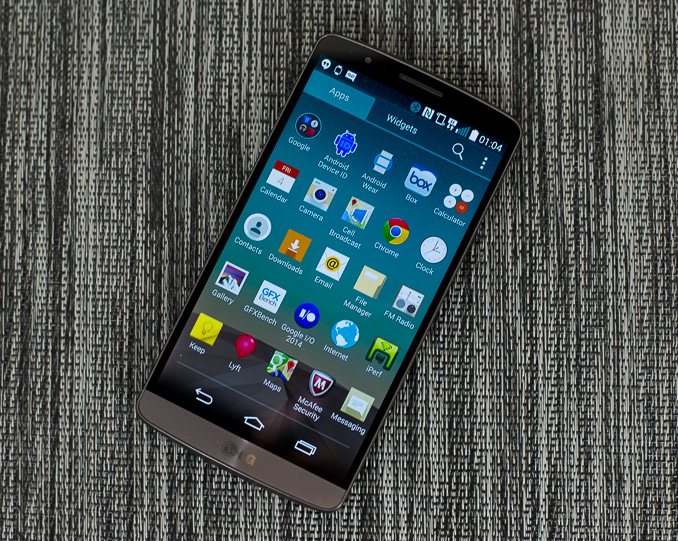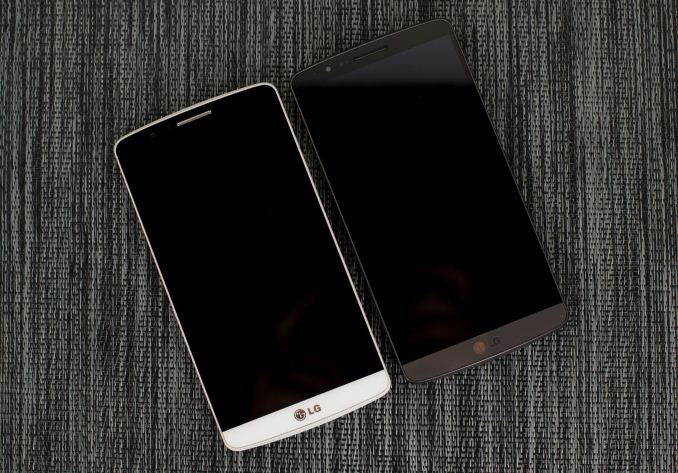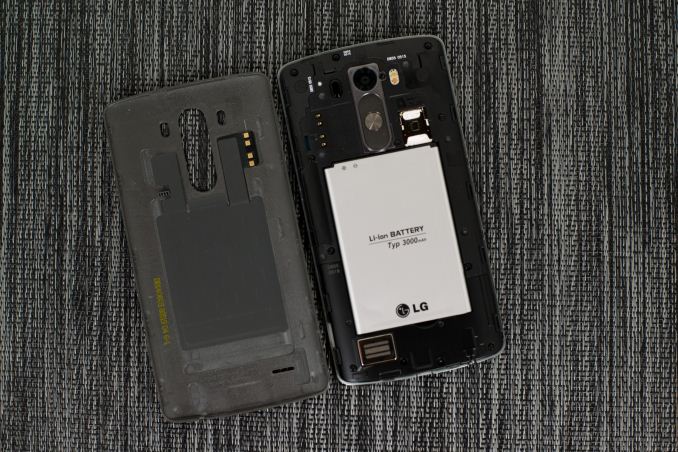The LG G3 Review
by Joshua Ho & Anand Lal Shimpi on July 4, 2014 5:00 AM EST- Posted in
- Smartphones
- LG
- Mobile
- Laptops
- G3

While the enthusiast segment is no stranger to LG smartphones, for the most part LG hasn’t received nearly the amount of attention that Samsung has. At first, it doesn’t make much sense. After all, LG is almost as big as Samsung. Both are chaebols, with enormous resources and power that few other companies have. Starting from the Optimus G, it seems that LG has shipped some of the best hardware in the industry, leveraging all the branches of the company from LG Innotek to LG Display to make a product that was easily equal to or better than the competition at the time.
One of the real issues that LG faced was a credibility gap. After the Optimus 2X and 4X HD, LG simply lacked credibility amongst the enthusiast audience. Without this audience and without the marketing push that other OEMs had, LG phones simply didn’t sell. Fortunately, things have gotten better since those days. The G2 brought significant attention to LG phones, and if anything, LG has been the sleeping giant in the industry. LG’s displays have been some of the best in the industry, and as an Android OEM they’ve consistently executed well on hardware. The immense popularity of the LG-made Nexus 4 and 5, even amongst mainstream consumers is surprising, especially because they were supposed to be developer devices.
Hardware
This leads us to the LG G3, which is now available in Korea and ready to be sold internationally. LG now faces the difficult task of succeeding the G2, one of the best phones of 2013. To find out whether they’ve made a worthy successor, we start with industrial and material design. When you first pick up the G3, it’s obvious that LG wanted to make a phone with the look and feel of brushed aluminum. To this end, LG has definitely done a good job. Although the polycarbonate back feels much warmer in the hand, the texture is good, and in practice even after extended use I never felt like the phone was grimy. It’s good to see that most of these OEMs are moving away from glossy finishes. The back cover is also removable, which allows for a removable battery and microSD slot. The front of the display is almost unchanged from last year, with extremely small bezels all around to reduce wasted space. The one change to the front of the phone is a band of color around the bottom that matches the color of the back.
Around the sides, the port layout remains nearly identical. The top has the IR Tx/Rx ports, the bottom has the 3.5mm jack and a microUSB port in the USB 2.0 shape. LG has also added a beveled edge from the display to the sides, which emphasizes the curved nature of the back. On the back of the phone, one can see the camera with the IR rangefinder and LED flash to the sides. The volume and power buttons are directly below the camera. The volume rocker is relatively flat compared to the protruding power button, which also has a noticeably different texture to distinguish the two from each other. The single, 1W speaker is towards the bottom.
Outside of these basic button and port placements, the hardware itself is high-end. The key differentiation points in this case are the camera system, QHD display, and the high-power speaker. I’ve put the rest of the basic specs in the table below.
| LG G3 | |
| SoC | MSM8974AC 2.45 GHz Snapdragon 801 |
| RAM/NAND | 3 GB LPDDR3, 32GB NAND + microSD |
| Display | 5.5” 1440p IPS LCD |
| Network | 2G / 3G / 4G LTE (Qualcomm MDM9x25 UE Category 4 LTE) |
| Dimensions | 146.3 x 74.6 x 8.9mm, 149 grams |
| Camera | 13MP rear camera, 1.12 µm pixels, 1/3.06" CMOS size, F/2.4. 2.1MP F/2.0 FFC |
| Battery | 3000 mAh (11.4 Whr) |
| OS | Android 4.4.2 with LG UI |
| Connectivity | 802.11a/b/g/n/ac + BT 4.0, USB2.0, GPS/GNSS, MHL, DLNA, NFC |
| SIM Size | MicroSIM |
While the spec sheet gives an idea of what to expect from the G3’s size, it’s surprisingly small for a 5.5” display size device. Unfortunately, this doesn’t make the G3 easy to use with one hand. While using the One (M8) and Galaxy S5 with one hand is uncomfortable, the G3 is almost impossible to use with one hand. Trying to tap something on the left side of the phone when using it with the right hand is difficult, and trying to reach for something on the top left of the display is almost impossible. While the division between phone and phablet is relatively clear in my mind, the G3 is in the line between both. I don’t object to the phablet formfactor, but this is supposed to be a phone, not a phablet. In addition, because the G3 has such thin bezels, it's very easy to accidentally activate the touch panel unintentionally while trying to stretch for one area of the display.
Other than the size, I definitely like what LG has done here. The design of the phone is understated and classy, even if it’s a bit off-putting that LG is trying to make plastic feel like metal. The back buttons are a non-issue, even without KnockOn/Off and KnockCode, and the curved back is great for ergonomics. However, I question the wisdom of moving to a removable battery/back cover in this case, as it means that there’s no stacked battery that we saw in the LG G2 and reduces volumetric efficiency. LG has included a curved battery in the G3, although in practice the curve isn't as aggressive as the one we've seen on the G2.













174 Comments
View All Comments
sherlockwing - Friday, July 4, 2014 - link
You listed Nexus 4 in the first Display Brightness graph then Nexus 5 in all the rest, could it be a typo?sherlockwing - Friday, July 4, 2014 - link
Nvm, I misread and didn't see Nexus 5.Niteowl360 - Friday, July 4, 2014 - link
Thank you for an awesome review.Technically better than most reviews whilst ensuring the layman remains in touch.
Only thing I found a little strange was the lack of excitement over the display.
Particularly most reviews have pointed to a slightly undersaturated display, in contrast to your findings.
Whilst your review states audio quality on per with the M8, I would have liked you to spend more time on this. After all we are still talking about a device which is primarily a phone!
I'm an HTC purist, but I believe HTC have continued to disappoint in the Camera department.
At the same time I believe the HTC logo and speakers however good, do come at an unacceptable wastage of display real estate.
I have always loved the realistic color saturation of HTC devices, and again raise reference to your findings on the over saturated G3 which seems to be a view shared by yourselves.
Thank you for an excellent overall review. Refreshingly detailed in substance.
Alexey291 - Sunday, July 6, 2014 - link
The display is of below average quality, albeit with higher resolution which reduces performance and battery life.Its a lot of tradeoffs for a small gimmick which is barely visible in reality.
zodiacfml - Friday, July 4, 2014 - link
Nahh, LG knew everything about this and just wants to compete with Samsung. How can LG beat Samsung's AMOLED display?I don't know but LG is probably not going the OLED route because Samsung's tech is superior.
peterfares - Friday, July 4, 2014 - link
This phone looks really awesome, especially finally going back to removable battery and SD card.But what's putting my off is the QHD screen. It's just a waste in every way. Waste of money. Waste of battery power. Waste of CPU and GPU resources. Waste of RAM. Shame. Everything else about this phone is AWESOME.
flyingpants1 - Friday, July 4, 2014 - link
Having onscreen buttons costs you 7% in screen are, and defeats the whole purpose of having a larger screen.Buttons should be capacitive, no bezel, and the browser UI and notification area should be cut down by about half.
Should have made a G2 with front speakers..A
UpSpin - Friday, July 4, 2014 - link
I disagree with you. On screen buttons vanish in full screen apps like games, video players, browser if you like, photo viewer, ... so practically no screen area is lost at all.On screen buttons allow a larger level of customization if you root. For example left right arrow in text fields once the keyboard shows up.
On screen buttons allow edge to edge displays. So practically you get a larger usable display at a smaller physical smartphone size.
If you feel too much space is wasted, I recommend you to root your smartphone, reduce the lcd density value, reduce the on screen button size and use the immersive mode of android.
Death666Angel - Saturday, July 5, 2014 - link
My on-screen buttons disappear when I'm not using them and almost all apps are good enough to use that space to display more stuff. Only means I have to swipe up or down to active them again, which hasn't been a hassle when using the G2 for the past 2 months. The design is much nicer as a result as well. My wifes SGS3 looks so ancient even compared to my Galaxy Nexus.Cruisecontrol - Friday, July 4, 2014 - link
Too bad about the display. That was one of the things I was hoping would make this phone stand out. I guess I'll have to wait to see if Samsung delivers an S5 Prime and what that has to offer.